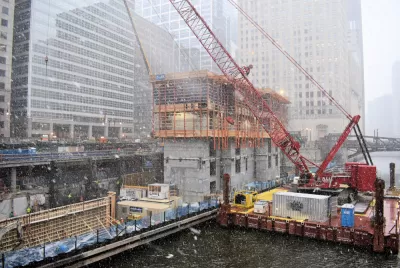Increasing allowable densities and reducing parking requirements are important strategies for achieving long-term planning goals, but to succeed they must be applied to large areas.

According to economic theory, an efficient and fair market must respond to consumer demands (called "consumer sovereignty"), so if the number of people who want to live in a neighborhood increases, zoning codes and development policies should respond by allowing more compact housing types (townhouses and apartments), higher densities and taller buildings, to serve these demands. Similarly, in multi-modal, transit-oriented neighborhoods where vehicle ownership rates are low, minimum parking requirements should be reduced or eliminated so residents are not forced to pay for expensive parking spaces that they don’t want.
I generally believe in this theory and support policy reforms to allow more compact development and reduced parking requirements, as discussed in previous columns, "How Filtering Increases Housing Affordability" and "Dynamic Planning for Affordability." I am therefore a YIMBY (Yes In My Back Yard), one of many researchers and advocates who support policy reforms that support more affordable infill development. This is a timely issue. Consumer surveys indicate that a growing majority of households want to live in walkable urban neighborhoods, and there are many benefits to residents and communities from serving that demand, so more households can find suitable housing in accessible neighborhoods.
Many people are skeptical that increasing supply increases affordability, but credible research indicates that filtering occurs, including Stuart Rosenthal’s 2014 study, “Are Private Markets and Filtering a Viable Source of Low-Income Housing? Estimates from a ‘Repeat Income’ Model,” published in the American Economic Review, and Miriam Zuk and Karen Chapple’s study, Housing Production, Filtering and Displacement: Untangling the Relationships, published by the Berkeley Institute of Government Studies.
A recent study, "The Effect of New Luxury Housing on Regional Housing Affordability" by Evan Mast, described in Daniel Herriges’s, The Connectedness of Our Housing Ecosystem, used an innovative approach to measure filtering impacts. It tracked the moving history of residents at 802 new multifamily developments in 12 cities. It found that building market-price apartments causes a kind of housing musical chairs, as households move into new units. This analysis indicates that for every 100 new market-rate units built, approximately 65 units are freed up in existing buildings, accommodating up to 48 moderate- and low-income families.
If you want more evidence that increasing moderate-priced housing increases affordability visit beautiful Montreal, where housing prices are 20-40% lower than in peer cities. Why? Because for the last century Montreal development policies encourage townhouses and low-rise apartment buildings in most neighborhoods. Similarly, recent experience indicates that even in high growth cities like Seattle and Portland, increasing rental apartment supply does drive down prices. During the last year these cities have built tens of thousands of new rental apartment units, and Seattle experienced a 2.4% decline, and Portland a 2.6% decline, in average rents, despite strong population and economic growth.
Yonah Freemark’s new study, "Upzoning Chicago: Impacts of a Zoning Reform on Property Values and Housing Construction," published in Urban Affairs Review, challenges those assumptions. This study of 2013 and 2015 upzonings around Chicago-area transit stations found that increasing allowable development densities by 17-50%, and reduced parking requirements around transit stations, increased existing housing prices by 15-23% (a similar order of magnitude as the increase in allowed density), but produced no additional new housing construction during the 3-5 year study period. Critics argue that this proves the futility of upzoning.
It is important to keep in mind the study's limitations:
- The study shows that upzoning increased property values, which indicates that developers intent to use this increased allowable capacity; otherwise they would purchase cheaper but lower density parcels. However, developing high rise buildings in existing urban neighborhoods generally takes years for approval, demolition, and construction. The two-to-five year study periods are simply too short for major new development to occur.
- It reflects particular market conditions. The study period (2013-2018) followed the Great Recession during which residential construction rates were relatively low (Freemark called it "a rocky period in the real-estate market"), and Chicago has essentially zero population growth so the region does is not experiencing the housing inaffordability and rapid development occurring in rapidly-growing cities like Los Angeles, New York, Seattle and Vancouver. This helps explain why new development was slow to start.
- The upzonings only affected a tiny portion of the city, the density increases only affected land within 600 feet, and the parking requirement reductions within 1,200 feet, less than 1% of the city's 178 square mile total area. As a result, only a small number of parcels were upzoned, and only a small portion of these are put on the market each year.
- The study did not account for unit size, so the additional allowable densities may partly result in larger units, suitable for families, which many communities want.
Because of the relatively small portion of regional land affected, this study is similar to anecdotes I often hear from affordability advocates: a few parcels are upzoned in a neighborhood, housing prices did not decline, proof, they claim that standard supply-and-demand functions do not apply to housing markets. Of course, small scale changes can have little effect, particularly in cities with significant latent demand for a particular housing type, such as moderate-priced housing in walkable urban neighborhoods. To drive down prices, upzoning must be scaled up and supported with public policies that favor moderate- over high-priced homes, such as apartment buildings over mansions.
If demand for living in transit-oriented neighborhoods is increasing, as surveys indicate, responsive development policies would allow densities to increase by comparable amounts, which requires much more than 17-50% density increases on less than one-percent of Chicago's land area. At that low rate, developers who want to fill the unmet demand have just a few hundred parcels to bid on each year, making it a seller's market; most of the potential value go to property owners, as Freemark found. A more responsive land market would allow much larger upzones over a larger area, so the supply of potentially higher density parcels is much larger.
Cities such as Seattle and Vancouver are implementing much bolder, neighborhood-wide upzonings that have much greater potential for increasing supply and driving down prices. They realize that to solve inaffordability the city needs to add tens of thousands of new housing units annually in order to catch up with population growth and decades of policies that restricted affordable infill. In fact, Seattle is already experiencing more affordable apartment rents due to previous policies that allowed more mid-rise multifamily housing development.
There may be other ways to encourage more affordable development. Land value taxes would reduce the tax increase that currently occurs when properties are developed to higher densities. Cities can increase allowable densities in exchange for affordable units, and reward developers who produce moderate-priced housing (in this case, those under about $200,000-600,000 per unit, which will initially be affordable to middle-income households, and increase affordable housing supply through filtering, and over the long run as they depreciate in value) with faster approvals and lower development fees.
Freemark's study demonstrates that upzoning is no panacea. It can increase housing supply and over the long run, but to succeed it must be applied to large areas so there is a competitive market for housing with significant development capacity. Increasing affordability requires a combination of strategies tailored to specific conditions. This should include upzoning and reduced parking requirements, appropriate inclusivity requirements (some affordable housing in market-rate buildings), affordable housing built on public land in accessible neighborhoods, reduced approval requirements and fees for moderate-priced infill housing, and public subsidies for social housing.

Alabama: Trump Terminates Settlements for Black Communities Harmed By Raw Sewage
Trump deemed the landmark civil rights agreement “illegal DEI and environmental justice policy.”

Planetizen Federal Action Tracker
A weekly monitor of how Trump’s orders and actions are impacting planners and planning in America.

The 120 Year Old Tiny Home Villages That Sheltered San Francisco’s Earthquake Refugees
More than a century ago, San Francisco mobilized to house thousands of residents displaced by the 1906 earthquake. Could their strategy offer a model for the present?

In Both Crashes and Crime, Public Transportation is Far Safer than Driving
Contrary to popular assumptions, public transportation has far lower crash and crime rates than automobile travel. For safer communities, improve and encourage transit travel.

Report: Zoning Reforms Should Complement Nashville’s Ambitious Transit Plan
Without reform, restrictive zoning codes will limit the impact of the city’s planned transit expansion and could exclude some of the residents who depend on transit the most.

Judge Orders Release of Frozen IRA, IIJA Funding
The decision is a victory for environmental groups who charged that freezing funds for critical infrastructure and disaster response programs caused “real and irreparable harm” to communities.
Urban Design for Planners 1: Software Tools
This six-course series explores essential urban design concepts using open source software and equips planners with the tools they need to participate fully in the urban design process.
Planning for Universal Design
Learn the tools for implementing Universal Design in planning regulations.
Clanton & Associates, Inc.
Jessamine County Fiscal Court
Institute for Housing and Urban Development Studies (IHS)
City of Grandview
Harvard GSD Executive Education
Toledo-Lucas County Plan Commissions
Salt Lake City
NYU Wagner Graduate School of Public Service






























